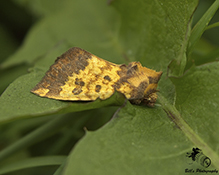golden borer
(Papaipema cerina)
Conservation • Description • Habitat • Ecology • Distribution • Taxonomy
|
|
||||||||||||||||||
Description |
Golden borer is a mid-sized, late season, borer moth. Adults are 11 ⁄16″ to 1″ in length. The forewing is bright yellow or pale yellow with pale brown scalloped lines; dark brown spots (reniform, orbicular, and claviform spots); a toothed, chocolate brown postmedial line; and a band of dark brown shading beyond that. The spots are said to be “outlined in brown”, but appear to be mostly outline. The reniform spot in the median area is narrowed in the middle appearing as two connected spots. The wing tip (apical area) is yellow. The hindwings are white. The antennae are slender and thread-like. |
Size |
Total length: 11 ⁄16″ to 1″ Wingspan: 2″ |
Similar Species |
Habitat |
Deciduous forest and woodland edges, prairies |
Ecology |
Season |
September through mid-October |
Behavior |
Middle and late instar caterpillars bore into the roots, rhizomes, and stems of host plants. Adults are sluggish, which may account in part for the scarcity of this species. They are active at night and are attracted to light. The wings are folded over the body when at rest. |
Life Cycle |
The eggs are laid in the fall and hatch in the spring. The larvae pupate in the summer and emerge as adults in late summer. |
Larva Hosts |
Eastern bottlebrush (Elymus hystrix) grass is the normal foodplant for early and middle instar larvae. However, the stalks are not thick enough to support older caterpillars, which move to may-apple (Podophyllum peltatum), lilies (Lilium sp.), dark green bulrush (Scirpus atrovirens). |
Adult Food |
|
Distribution |
||
|
Sources |
|
| 8/16/2025 | ||
Occurrence |
||
Uncommon |
||
Taxonomy |
|
Order |
|
Superfamily |
Noctuoidea (Owlet Moths and Allies) |
Family |
Noctuidae (cutworm moths and allies) |
Subfamily |
|
Tribe |
Apameini (arches) |
Genus |
Papaipema |
There have been three major revisions of the family Noctuidae since 2006, each placing the genus Papaipema in a different subfamily, Amphipyrinae, Hadeninae, and Noctuinae. All three subfamilies are currently used for this genus by various sources. |
|
Subordinate Taxa |
|
|
|
Synonyms |
|
|
|
Common Names |
|
golden borer golden borer moth |
|
Glossary
Instar
The developmental stage of arthropods between each molt; in insects, the developmental stage of the larvae or nymph.
Visitor Photos |
||
Share your photo of this insect. |
||
This button not working for you? |
||
Bill Reynolds |
||
The moth is resting on a Dandelion leaf and had no desire to move on this cool day. |
||
 |
 |
|
 |
||
MinnesotaSeasons.com Photos |
||
|
||
|

Slideshows |
|

Visitor Videos |
||
Share your video of this insect. |
||
This button not working for you? |
||
|
Other Videos |
||
|

Visitor Sightings |
||
Report a sighting of this insect. |
||
This button not working for you? |
||
| Bill Reynolds 9/14/2017 |
Location: Pennington Co. MN The moth is resting on a Dandelion leaf and had no desire to move on this cool day. |
 |
MinnesotaSeasons.com Sightings |
||
|

Created: 9/17/2017 Last Updated: © MinnesotaSeasons.com. All rights reserved. |
